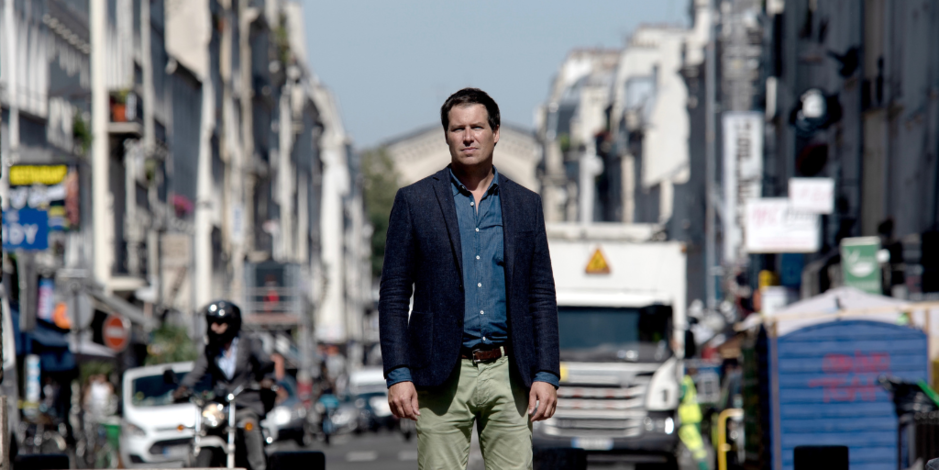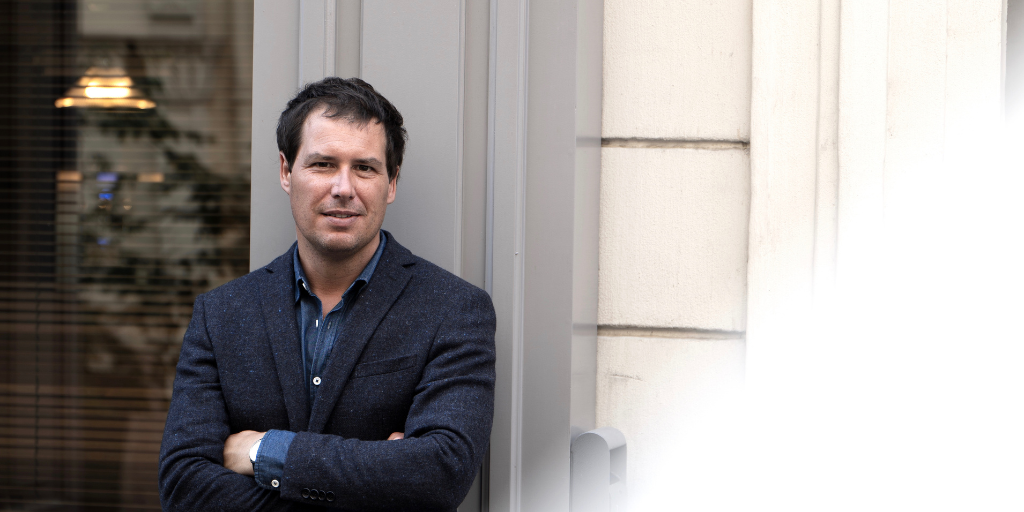The Dark Digital Cloud: How New Technology is Costing the Earth
Guillaume Pitron has been regularly sharing his research and insights with HEC students ever since he published his award-winning book “The Rare Metals War” in 2018. He is currently working on his third non-fiction study, assisted by a two SASI Master students. Pitron recently presented HEC students and academics his second book, “The Dark Cloud”, on the dystopian world of our digital lives. Pitron shared his two-year investigation into the underbelly of Big Tech, pointing to the environmental and ethical costs of their smartphones, mobile computers and electric cars. A stark warning about how the energy transition “has become an energy addition”.

© Reda Settar
Before starting to write this article, I prepared with 12 Google searches on my laptop HP computer. This was connected via 5G to Internet. I interrupted my research to drive my ‘non-polluting’ electric car to the office where I then sent a Meta “Like” towards a colleague for her successful defense of a Ph.D. I emailed my father with a photo attachment of the family. I also used my Apple iPhone to warn my doctor I would be ten minutes late… via the DoctoLib platform, naturally.
Anodyne gestures which literally billions of people worldwide have been doing increasingly in one form or another this past decade or more. For, never has the world been more connected, and the exponential curve keeps curving more steeply. Yet, by Guillaume Pitron’s calculations, my clicks and activities have, in the space of an hour, increased my carbon footprint by hundreds of kilograms, or its carbon dioxide equivalent (CO²e)… This contribution will add to my toll which, if I’m an average person in France, came to 11.9 tons of CO²e in 2020. Let’s break it down:
- My “Like” crossed seven operating layers of the Internet, exploiting submarine copper cables, telephone antennas and data centers cooled down in the Artic Circle. That can also be applied for my use of the DoctoLib platform.
- My 12 Google searches used as much energy as a lightbulb lit for 16 minutes.
- My email with a large attachment was as energy consuming as a lightbulb left on for an hour. The geography of an email is one of the most neglected parts of the Internet revolution.
- My new iPhone is the result of 182 kilos of raw material, including rare metals like lithium. The electronic chip it harbors needed 32 kilos of this same material.
- The battery in my five-year-old electric car takes seven years to reach net-zero CO²; before then, you have to calculate in the cobalt, nickel, manganese and lithium needed to make it.
Low Carbon Means High Resource
These are just a few extrapolations from Guillaume Pitron’s chilling second book “The Dark Cloud”, superbly translated from French into English by South African Bianca Jacobsohn. The two-year investigation by Pitron uncovered the price we pay for dematerialization. Its aim was to understand why dematerializing our world eats up 10% of the globe’s electricity and represents almost 4% of planet’s carbon dioxide emission. “What we have to realize is that a low-carbon world needs a high-resource planet,” the French reporter told a packed auditorium at a conference this fall, when first sharing his book to a packed HEC auditorium. “There is a minimum of 60 metals in this contraption,” he continued, fishing out his own smartphone from his pocket. “The technology behind it is as complex and rich as what was used to send someone on the moon. And what you must realize is that the more our world becomes virtual, the more it needs material.”
Since Guillaume Pitron was last on the Jouy-en-Josas campus in 2022, he has been busy. Very busy. His gripping investigation into the dark side of our digital technology became a global odyssey spread over two years. It took him to China’s northernmost province of Heilongjiang and its graphite mines; to the haunting Science Park 610 in Amsterdam harboring one of Europe’s fastest data exchange centers; to Estonia’s fortified city of Tallinn which has gone “fully digitalized”; to the French city of Grenoble, host to Europe’s only new-generation chips industrial site; to the US’ Appalachian region where coal mining continues unabated as an unlikely player in the country’s stated carbon neutrality objectives. And as far as Boden, a remote part of Lapland, Sweden, where Pitron sees close up the Meta building exterior and the entrails of the hydro66 data center. In his book, Pitron’s details the sensation when entering its warehouse: “My ears are the first to be assaulted, as machines emit the strident buzz of a billion bothered worker bees. Next is my sight: row upon row of metal racks containing servers lined up under green lights… Surrounding the roaring hall is countryside encased in meters of powder snow.” Indeed, Sweden is seen as an El Dorado for the world’s leading web users, with Meta’s two data centers alone accounting for 1-2% of the energy the country generates.
Rays of Light Piercing the Cloud?
These are two of 3 million data centers in the world which make up this “dark cloud”. They are increasing the global consumption of electricity by 15% a year. Add to this, the rare metals, and the copper needed for the 1.2 million kilometers of cables our data goes through, and, well …: “the energy transition becomes an energy addition,” notes Pitron. “By consuming less petrol, we are consuming more metal. A low carbon world needs artificial soils, which rarifies resources, slashes biodiversity, and pollutes both air and ground.”
Yet, Pitron does see rays of lights which could break through this dark cloud. The French journalist describes them in his book and shared some with the students: “It can start with our habits. By choosing Wi-Fi over 4G, for example, you consume 23 times less electricity. Think about switching off the Internet box when you’re not at home. Watch movies at low, not high definition, which saves 4-10 times electricity. Or, join the global Digital Cleanup Day that was started in Estonia three years ago. Every March, participants clean up their storage space (email, Google Drive, Dropbox) or ‘throw out’ their old photos and videos, useless emails, etc. All gestures have an impact on our carbon footprint.”

Meanwhile, Guillaume Pitron continues to explore the jagged edges of our technological revolution and its ecological impact. “I want to investigate new themes which presage the world to come. And so my next inquiry will once again cover a wide array of disciplines ranging from geopolitics to economics and ecology.” For this new investigation, Pitron will once again turn for help to students and interns from HEC, Science Po and the CFJ school of journalism, who will plunge into topics far from the public eye. “Without their help it would take me 10 years to finish my books!” he confides. “I rely on this dedicated team to uncover what the powers-to-be would prefer to hide. Students, including some from HEC, write up many of the 40-50 topics which make up a book, 10 to 100-page analyses each, from which I keep the very essence.” In “The Dark Cloud”, Pitron also acknowledges the contribution of the likes of Gwendoline Créno (H20): “Without their passion for the issues evidenced in this work (and) their close and constant attention to checking the facts… this book would not be the one you have in your hands today,” he writes. Créno’s contributions ranged from research on the paradoxes of the Greta generation, to the connection between smartphones and Zen Buddhism. Two students from this year’s SASI Master, Emma-Louise Simon and Castille Jacquet will further this HEC-Pitron collaboration for the latter’s third book - to be published by the same LLL Editions which brought out his first two books.